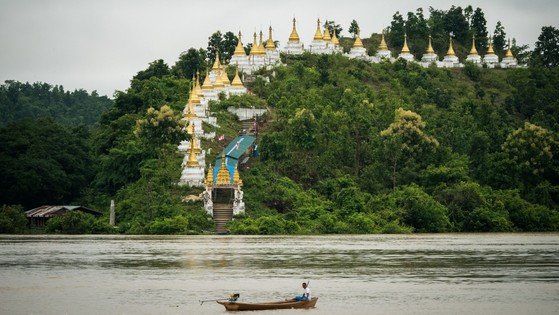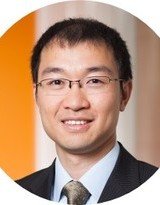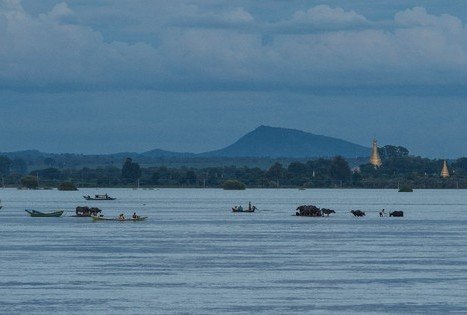Humanity Along the Chindwin (Part 1)
 Golden pagodas along Chindwin River. (Photo by Ir Dr. Derrick Pang, JP)
Golden pagodas along Chindwin River. (Photo by Ir Dr. Derrick Pang, JP)
Text by Ir Dr. Derrick Pang, JP
Working full-time running a listed company, I find myself drowned by daily routines and have little time to explore my creative side, as a businessman or an amateur photographer. Or maybe I have been living in Hong Kong long enough that things just don’t excite me enough for me to get my camera out. However, when I travel, unfamiliar places and people stimulate me and open up my creativity side. Last year, my brother gave me a perfect gift, a photography trip with China Exploration and Research Society (CERS), which he won from a charity auction. I would get to spend time with Wong How Man, the president of CERS, on an exploration trip to Myanmar. I knew very little about Myanmar and only recently had visited Yangon on a Belt and Road delegation. That trip highlighted the new government and Myanmar’s growth potential, and the delegates saw the “good” side of the country, but never saw the undeveloped regions, in which water and electricity were scarce.
CERS exploring Myanmar sounded very exotic. For me “exploration” means adventures and discovering rare species. Before the trip, I received a long list of items and an itinerary from CERS’s Logistic Director, Berry Sin. I noticed nothing unusual, from sunscreen to sandals; and thought to myself, “O good, nothing too difficult”, but realized that I would be spending 10 days on a boat. I didn’t really know CERS and only had met How Man twice. So, I really didn’t know what to expect. There was a bit of suspense; but mostly excitement.
After arriving Mandalay, we drove a few hours to Monywa to board the boat, the HM explorer. It provided all basic needs in a civilized manner; nothing extravagant, and don’t expect cruise-type accommodations. We all had our own rooms of around 30 sq. ft. and shared common bathrooms. The deck of the boat was where we spent our time - gazing at the two sides of the river and enjoying drinks and snacks during happy hours.
.jpg) Boarding the HM Explorer on the first day. (Photo by Ir Dr. Derrick Pang, JP)
Boarding the HM Explorer on the first day. (Photo by Ir Dr. Derrick Pang, JP)
We would be traveling northward on the Chindwin River. On the first afternoon, we traveled two hours to get out of Monywa before the river was officially closed due to rapid current caused by recent flooding. We were fortunate that the flood allowed us to navigate smoothly without getting stuck on the shallow river bed; but unfortunately, for the locals, the flood caused havoc. One thing that I realized within the first two hours were the numbers of golden pagodas. I later understood that each individual village had their own temple, sometimes more than one, and the typical temple structure was a golden pagoda. With many different villages established along the two sides of the Chindwin, these golden pagodas could be seen every 3 to 5 mins while our HM explorer traveled at a speed of 10km per hour.
We anchored at a quiet area to spend our first night. When we woke up around 8am the next day, How Man took me to a local wet market. All kind of fish, meat, veggies, dry foods, and daily necessities were sold. Flies were everywhere and the ground was a muddy mess because of an earlier rain. I remembered the market reeked and thought hygiene was a major issue here. I wondered if many Burmese would get sick under this environment, but then people were probably used to it and immune to these germs. I was the one that needed some adjustment. In the beginning, I was so busy dancing through water puddles and manure that I forgot to pull out my camera.
.jpg) Morning buyers at a local wet market. (Photo by Ir Dr. Derrick Pang, JP)
Morning buyers at a local wet market. (Photo by Ir Dr. Derrick Pang, JP)
We continued our journey on the third day and stopped by a local village in the morning. We visited a village school, or I should say local classrooms; as a few classrooms were the school itself. Each classroom was equipped with basic necessities, including a few blackboards and plastic tables and chairs. While one lightbulb was hanging from the ceiling of each classroom, the room was illuminated by sunlight through open windows. Air conditioners or multimedia equipment were beyond their budget. When students saw us coming into the village, they seemed excited and romped around with their bare feet. It took the class teacher a few minutes to calm them down and get them ready for class. I could tell the teacher was a bit annoyed because of the distraction, but she was too courteous to say a word. I could imagine that the students didn’t get to see the outside world very much, and we were their window to their outside world. One of us attracted a crowd of kids when he showed photos stored in his digital camera, a scene similar to what I remembered when I visited Yunnan 20 years ago.
We continued our journey throughout the day, and arrived at Kalewa in the evening. After being trapped in the boat for most of the day, we took off immediately on foot to the monastery near the shore. The golden pagoda gave the false impression that these monasteries were prodigal. We were asked to walk with bare feet, which was the local custom within Myanmar. After walking up the concrete steps, we were met with a modestly built structure, providing a quiet place for people to worship, but nothing more. We walked around the village a bit. While the village was backwards, it was tidy. By the end of the day, I realized that I would not be adventuring into new territories nor finding new species. But I would get to see how Burmese live their lives along the Chindwin. A reminder of how people can live with just a few basic necessities.
Just when I started to think that we would be staying on the boat for most of the time, How Man suggested a trip into India the next day. We drove four hours the next day along India-Myanmar Friendship Road to Tamur, a city that sits at the border of the two countries. A market sold all types of goods, from Chinese made DVD players to imitation Nike sneakers, as well as daily necessities. The market was vibrant with heavy traffic of people going in and out of Myanmar and India.
.jpg) Traders at the market of Tamur. (Photo by Ir Dr. Derrick Pang, JP)
Traders at the market of Tamur. (Photo by Ir Dr. Derrick Pang, JP)
Our first attempt to get into India failed as this route was only meant for locals. I was going to ask How Man to get us some thanaka to put on our faces to pretend to be Burmese. I gave up the idea when I realized that mostly only women wear thanaka.
Instead, we took a backdoor route on motorcycles through bush. It was exhilarating with all the maneuvers around trees and puddles. Just when I thought I had enough of the bumpy ride, we arrived at Chanpol, a village in Chandel district of Manipur. Only fifteen families live in this area now, as approximately 150 families were chased out of their homes by Indian soldiers a few years ago. Their lands were taken away, but now a few of them had come back to reclaim their property. Life was very simple for these villagers - they raised some chickens and cows, and aside from their huts, these animals were likely their only valuable assets. One of the villagers took us around to show us the worn-down chapel. She was trying to raise money to rebuild it. To them, our few Benjamins made all the difference. Our brief visit to India was memorable, as this was my first interaction with local villagers and an opportunity to understand their ways of living. (To be continued)
*This article was published in China Exploration and Research Society (Autumn 2017)

2018-01-19
By Ir Dr. Derrick Pang, JP
Chief Executive Officer
Executive Director
Tags:





Leave your comment